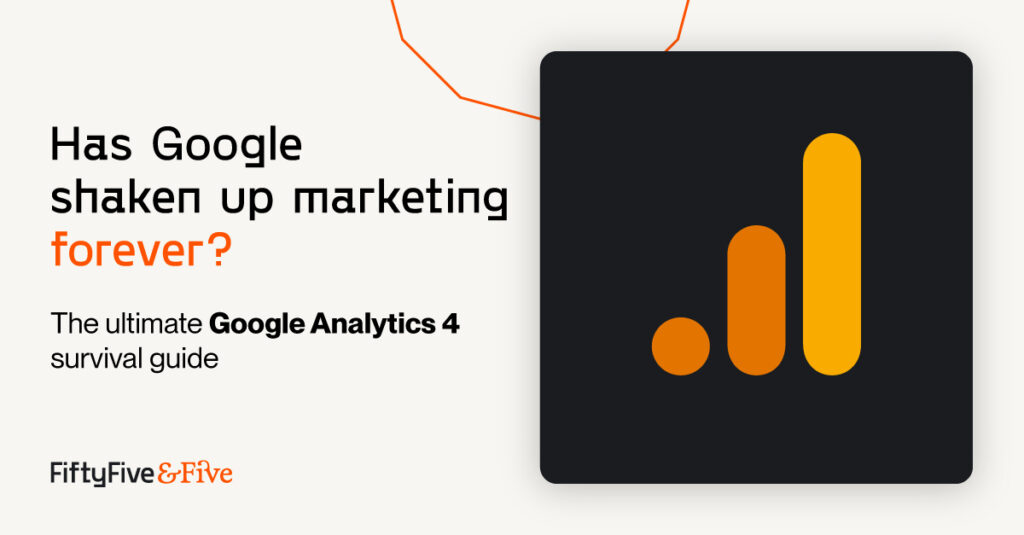Has Google shaken up marketing forever?
Welcome to a new era of marketing analytics.
Google has radically transformed its popular analytics platform with the launch of the latest iteration, Google Analytics 4 (GA4). These changes can genuinely be described as “seismic” – for two reasons.
Warning: Seismic activity detected
Reason 1
Does “popular” really do Google Analytics justice? It’s central, fundamental even, to any web-based marketing. Therefore, any significant changes are seismic due to the sheer number of marketers affected.
Reason 2
These are by no means small changes. Google isn’t rearranging the furniture but demolishing the house, and then building something entirely new. The truth is GA4 will change how marketers plan, execute and report their marketing efforts. Expect a sizeable learning curve – one that’s worth getting started on as early as possible.
Hold on tight, the future’s here
We’re here to help. The first step is to understand why these changes are happening, what’s new, and what it means for marketers. Has Google Analytics 4 changed marketing forever? Let’s find out.

Give it to me straight, Doc… what is Google Analytics 4?
First, let’s ask what Google Analytics is not. It’s not Universal Analytics (UA) – the analytics model first released in 2012, which has underpinned how Google Analytics looks, feels and functions ever since. Google has announced that Universal Analytics properties will stop processing new data on July 1, 2023.
Hands up who loves change
GA4 signals the beginning of a new era. It’s a tectonic shift in how we measure marketing success, shaking up how we think about what marketing is and what marketing can achieve.
Rather than measuring web page sessions, bounce rates and unique visits, it will instead shine a light on engagement and cross-platform customer behaviour. There’s a bunch of new metrics to work with too (more on that later). With GA4, the focus is on measuring the customer lifecycle rather than how well a particular campaign or a web page performs.
Explosive, exciting, epoch-defining
When tectonic plates shift, it’s often explosive. Yet, with GA4, there’s a notable excitement bubbling up in marketing circles about it. These changes should delight forward-thinking marketers who have no doubt been left frustrated by the limitations of Google Analytics in recent years.

A radical overhaul? It’s about damn time
“It takes an earthquake to remind us that we walk on the crust of an unfinished planet.” – Charles Kuralt.
Since Universal Analytics arrived in 2012, a lot has changed. Digital technology had already changed how people interacted with organizations. Mobile was very much the new normal before 2020. So too was the expectation for lightning-quick, mobile-first and highly personalised customer experiences. Essentially, a data-driven customer-first approach was required. And Google Analytics left marketers wanting in many key areas.
Hi Google, fix these please
There are four major areas where change was most needed. And it’s at these fault lines that Google Analytics 4 is opening up new ground for marketers.
1. Engagement across the entire user journey
With customer experience prioritised, it’s essential for organisations to take a more holistic view of the customer journey. Pinpointing engagement on a particular campaign is no longer enough. Metrics that showed engagement levels over the entire customer lifecycle were more useful but were sorely lacking in previous iterations of Google Analytics.
2. Facilitates multiple platforms
Customers also wanted to interact with brands across platforms, channels and devices – all while offering personalised experiences tailored to them. In the US, 98% of people say they use more than one device on a daily basis. So, getting this right has proven to be a key marker for success. Additionally, research has found that using three or more channels in a marketing campaign earned a 287% higher purchase rate than a single-channel campaign.
3. More AI and machine learning
Machine learning has come a long way in a short time. It’s now being implemented in numerous ways in a marketing context. Many of the personalised experiences that customers expect involve piecing together patterns and trends in customer data. As these methods evolve and become more sophisticated, larger and increasingly complex datasets are required, which Google Analytics was not necessarily capable of providing.
4. Customer privacy
As the demand for personalisation grows, so does the need for customer data. And then, at the same time, perhaps unsurprisingly, so too did the demand for higher data protection and privacy standards. When General Data Protection Regulation (GDPR) and similar regulations were introduced, many companies reacted in panic.
Around that time, Wetherspoons deleted their entire mailing list – although stating it was due to a change in strategy rather than the introduction of GDPR. Tighter rules around customer data do pose a problem for marketers. There needs to be a more nuanced and sophisticated approach to using customer data in a way that protects privacy but still allows for creative use of personalisation.
Marketing: An unfinished planet
Marketers are pretty good at staying on our toes. Our inboxes are jam-packed with news of the latest marketing trends and transformative tools. Yet, the Google Analytics of the Universal Analytics age always seemed like an immovable, monolithic titan of the marketing toolset. But nothing in this world stands still for long.
Universal Analytics was struggling to keep up with the rapid change in marketing trends. And that was becoming a more significant issue every day. Enter Google Analytics 4 – a new take on analytics to reflect modern marketing needs. GA4 gives marketers a new set of tools to adapt to the demands of a world where customer experience is king.
Now the fun part. Here’s what’s new.
There are many new GA4 features that we could pick out. However, these are the most significant.
Makeover madness
The first big transformation most marketers will notice right away is the visuals. There’s a new dashboard, user interface and navigation. Design changes on this scale always take a little while to get used to. But having played around in GA4 for a few months, we’re really impressed with the new look.
Cross- and multi-platform fun
When in development, Google Analytics 4 was given the code name “App + Web”. This is a big hint at what is the central difference between GA4 and previous iterations. GA4 brings reporting on app and website usage together in one report. These two key areas are no longer separate entities but are part of a holistic and simplified view of marketing data. This is part of Google’s goal to give users valuable insights into the entire customer journey from acquisition to retention. Now you get in-app and web data for Google Ads, as well as non-Google paid campaign reporting – all in one place.
New metrics, new you
There are a bunch of new metrics to measure engagement across platforms, devices and channels – as well as to facilitate more comprehensive insights into the customer lifecycle. These metrics are at the heart of the new customer-first approach, moving us away from focusing on traffic, marketers now have a selection of bespoke metrics designed to lift a lid on the customer journey.
What's new: active users, engaged sessions, engagement rate and scroll depth.
What's gone: average session duration and pages per sessions.
Events, events, events
GA4 handles data in a different way to Universal Analytics. Say goodbye to sessions and pageviews. Instead, say hello to events-based measurement. You can set parameters that measure user engagement at various touchpoints, called events. Four new types of events have been added to achieve this: automatically collected events, enhanced measurement events, recommended events and custom events.
No appetite for cookies
Google Analytics 4 helps marketers make use of customer data safely and securely with granular controls for data collection and usage. In fact, GA4 does not store IP addresses altogether, which will help marketers stay compliant with international data protection legislation. There are also country-specific privacy controls to make this as simple as possible. This is the beginning of a world without cookies. A quick look online and that world might seem impossibly far away. But Google has committed to retiring the use of cookies in Chrome by the end of 2024.
AI, magic or both?
Google Analytics 4 is powered by the latest machine learning technology. And data privacy is one of the areas to really benefit from this. Machine learning models can take relatively limited datasets, e.g. those restricted by data protection law, and deliver sophisticated, far-reaching predictive insights. In particular, GA4’s predictive models can be used to identify customer behaviour, such as likelihood of making a purchase. It can also provide useful insights on the predicted revenue that a set audience will generate for your business. It will highlight the customers that are disengaged and at risk of falling out of the marketing funnel altogether.
A new dawn awaits
With Google Analytics 4, marketers can now access tools that allow them to successfully navigate the challenges of modern marketing.
What does this mean for marketers?
Has Google changed marketing forever with Google Analytics 4?

Yes. But it’s great news, and it’s exactly what every marketer needs right now.
A few challenges but many, many benefits ahead
There’s no getting around the fact that Google Analytics 4 is going to take some getting used to. And there will be a learning curve. It might take a while for everyone to get to grips with the new metrics, dashboard and reporting.
However, the hardest part might not have anything to do with how the marketing team functions. On the whole, marketers will be delighted with Google Analytics 4. The challenge will be communicating what’s changed and why to wider stakeholder groups, whether that is the c-suite, clients or other colleagues.
A modern platform for modern marketing
GA4 reflects how marketers want to put campaigns together. Marketers will now have more control over the data that drives marketing success. They have more advanced tools built to help them keep customers happy, accurately predict outcomes and make data-driven decisions.
With GA4, marketers can:
- Deliver campaigns tailored towards increasing engagement
- Track and monitor customer data seamlessly across platforms, channels, and devices
- Draw upon analytics and predictive insights that shine a light on every aspect of the customer journey
Now it’s over to you
The truth is that when the results come in, when people start seeing increased engagement, higher sales’ numbers, customer retention going through the roof – it will be easy to see the value in Google Analytics 4. With Google shutting shop on Universal Analytics properties on July 1, 2023, it’s definitely time to start your switch to Google Analytics 4. Good luck.
Fifty Five and Five provide consultancy, strategy, and execution services for performance marketing as well as build tools and applications to accelerate marketing excellence in an age where every inch counts. If you have any questions about Google Analytics 4 and the future of marketing, get in contact with the Fifty Five and Five team today.
Want to learn how Google Analytics 4 affects your business?
If you want to discuss what GA4 means for your business specifically, or understand what your next steps should be, then contact us to have a little chat.

